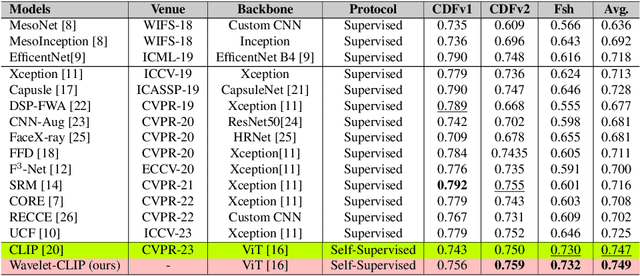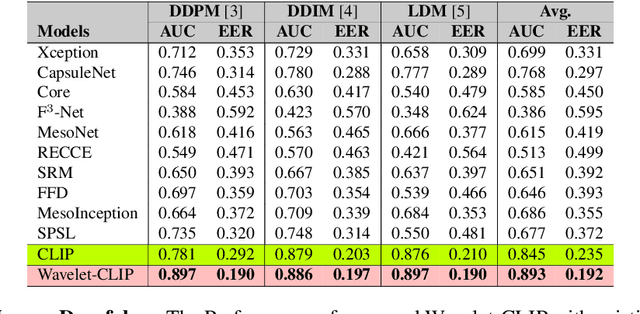Shilhora Akshay Patel
Harnessing Wavelet Transformations for Generalizable Deepfake Forgery Detection
Sep 26, 2024


Abstract:The evolution of digital image manipulation, particularly with the advancement of deep generative models, significantly challenges existing deepfake detection methods, especially when the origin of the deepfake is obscure. To tackle the increasing complexity of these forgeries, we propose \textbf{Wavelet-CLIP}, a deepfake detection framework that integrates wavelet transforms with features derived from the ViT-L/14 architecture, pre-trained in the CLIP fashion. Wavelet-CLIP utilizes Wavelet Transforms to deeply analyze both spatial and frequency features from images, thus enhancing the model's capability to detect sophisticated deepfakes. To verify the effectiveness of our approach, we conducted extensive evaluations against existing state-of-the-art methods for cross-dataset generalization and detection of unseen images generated by standard diffusion models. Our method showcases outstanding performance, achieving an average AUC of 0.749 for cross-data generalization and 0.893 for robustness against unseen deepfakes, outperforming all compared methods. The code can be reproduced from the repo: \url{https://github.com/lalithbharadwajbaru/Wavelet-CLIP}
A Novel Strategy for COVID-19 Classification from Chest X-ray Images Using Deep Stacked-Ensembles
Oct 07, 2020



Abstract:The issue of COVID-19, increasing notably with a massive mortality rate has led to the WHO declaring it as a pandemic. The unavailability of an antiviral drug has also led to dismay world-wide. The diagnostic tests are performed by collecting samples inserting a swab into the nasal or oral cavity. These collected samples and then sent to laboratories for viral-tests. Recently, chest radiographs are used to observe the proportion of virus in the lungs at various section-scans. As laboratory testing is time-consuming with a lot of human effort, diagnosis using chest radiographs is considered to be a befitting choice. In this research, a stacked-ensemble model is designed to classify whether a patient is infected with COVID-19, viral-pneumonia or has a healthy profile by considering chest X-ray images. A lot of complications were observed from existing literature in classifying COVID-19 radiographic images and are eliminated using our methodology. A training algorithm is constructed to speed up the training process which acquired good generalisations. The proposed model resulted in state-of-the-art outcomes with an accuracy score of 99.48% for binary classification and 97.4% for tri-class classification. Additionally, visualisations are illustrated for a detailed comprehension of the model's perception for the information provided to it.
 Add to Chrome
Add to Chrome Add to Firefox
Add to Firefox Add to Edge
Add to Edge